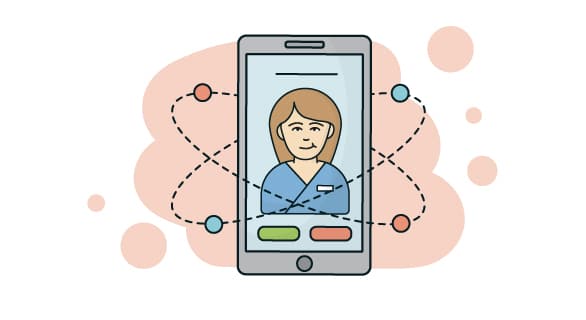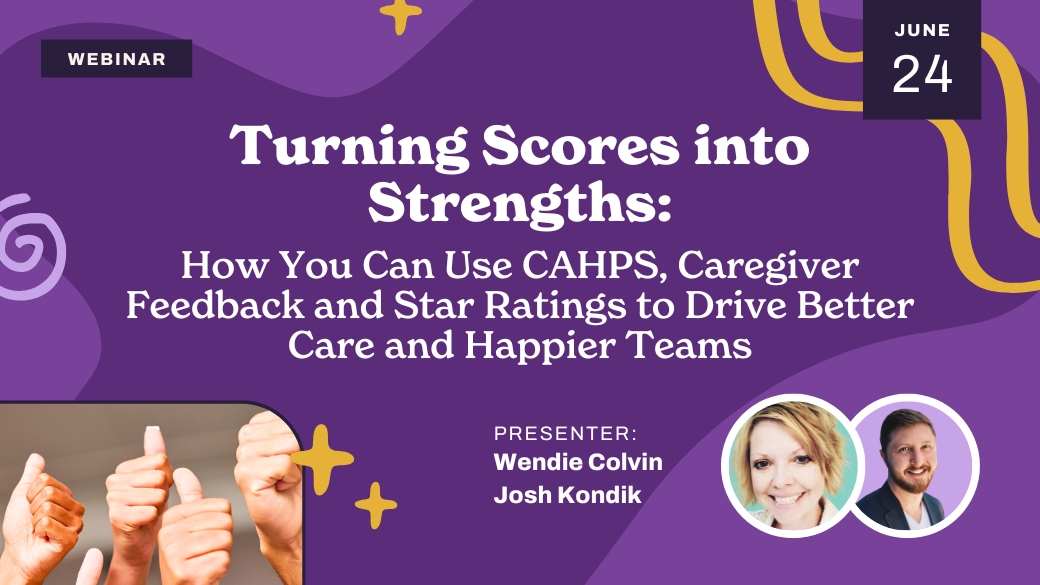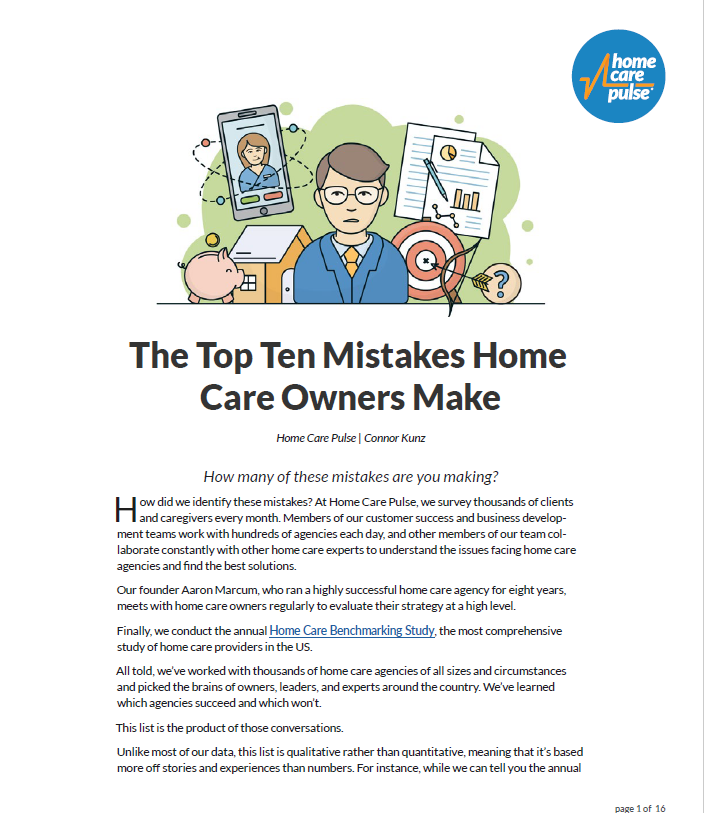The Top Ten Mistakes Home Care Owners Make

How many of these mistakes are you making?
How did we identify these mistakes?
At Activated Insights, we survey thousands of clients and caregivers every month. Members of our customer success and business development teams work with hundreds of agencies each day, and other members of our team collaborate constantly with other home care experts to understand the issues facing home care agencies and find the best solutions.
Our founder Aaron Marcum, who ran a highly successful home care agency for eight years, meets with home care owners regularly to evaluate their strategy at a high level.
Finally, we conduct the annual Home Care Benchmarking Study, the most comprehensive study of home care providers in the US.
All told, we’ve worked with thousands of home care agencies of all sizes and circumstances and picked the brains of owners, leaders, and experts around the country. We’ve learned which agencies succeed and which won’t.
This list is the product of those conversations.
Unlike most of our data, this list is qualitative rather than quantitative, meaning that it’s based more off stories and experiences than numbers. For instance, while we can tell you the annual caregiver turnover rate for the industry (81.6%), we don’t know the exact percentage of home care owners who make mistake #5: viewing caregivers as replaceable commodities rather than priceless assets. We do know, however, that it’s a critical issue because we talk to home care owners with this perspective every day.
Table of Contents
Click on a link below to skip to the sections that are most interesting to you, or keep scrolling to read it through.
Mistake #1: Not uniting your staff around a clear why
Mistake #2: Underestimating the Internet
Mistake #3: No differentiation strategy
Mistake #4: Not putting feedback-gathering processes in place
Mistake #5: Viewing caregivers as replaceable commodities
Mistake #6: Under-utilizing technology to automate your work
Mistake #7: Focusing more on getting leads than converting them to clients
Mistake #8: Not orienting your staff around common goals
Mistake #9: Relying too much on gut to make decisions
Mistake #10: Letting your agency run you
A Word on Vulnerability
As researcher and author Brene Brown has said: “Vulnerability is the birthplace of innovation, creativity, and change.”
It’s rarely easy to take criticism of yourself or your business. By reading this guide, you’re already setting yourself ahead of the curve by being curious and willing to learn. The true test, however, is whether you’ll be vulnerable enough to honestly evaluate which of these mistakes you might be making, and take the steps necessary to make them strengths rather than weaknesses.
Mistake #1: Not having a clear why—and helping your staff buy into it

When we say why, we mean purpose, vision, and guiding principles—why did you start your business and why do you get up in the morning?
Home care owners are almost always incredibly compassionate people, and most of you are motivated in one way or another by helping people live better lives.
If you’re like most home care owners, you’re in home care because you care deeply about people. However, what we’ve realized is that many home care owners don’t make their vision specific enough and don’t communicate well to their staff and caregivers so that they buy in with the vision too.
For them to be part of your agency’s mission, they need to connect with it personally and feel like they have a stake in it.
It’s not enough to be driven by purpose yourself: you need to articulate it in a way that gets others on board too. You should focus on spreading it in this order: office staff, caregivers, clients, local community.
What You Can Do Today
1. Meet with your admin team to create a clear, specific mission statement and core principles. If you already have them, meet with your team to reevaluate them. Your leadership team needs to be involved in developing them so that they feel a personal stake in it. We recommend you download our Defining Your Why Guidesheet to get started.
2. Discuss how to integrate your mission/values into every aspect of your communications and brand. Here are some places you can start:
Read More
Mistake #2: Underestimating the importance of the Internet, especially in marketing

It’s almost impossible to underestimate the importance of the Internet, especially in getting found by potential clients. Even if the clients themselves aren’t using the Internet to search for care, their family members are.
A recent study showed that 84% of people read online reviews about businesses.
MYTH: stuff like Search Engine Optimization (SEO) and online reviews don’t work very well in home care. It’s just the nature of the business.
FACT: 8 of the top 10 ways leading home care agencies are marketing to consumers are online channels, according to the Home Care Benchmarking Study.
You’re probably already using the Internet quite a bit. Like most agencies, you probably have invested some time in online profiles to get reviews, and you probably have an online presence through your website, Facebook, and maybe other sources as well.
Don’t stop there. The Internet is taking over home care marketing—and the agencies who succeed in the future will be those who getting ahead of the curve now.
What we’re finding is that a mixture of different factors are causing many agency owners to do one of two things: Either they use the Internet heavily but fail to use the right tools on the Internet, or they undervalue the Internet in general. Most mistakes are common.
How do you know if you’re using the right tools? First, track your client acquisition cost and billable hours gained for each marketing source you’re using. Over time, you’ll be able to optimize your marketing by narrowing it down to the sources that perform the best in your area.
Second, use our tips below as a starting point. We’ve broken it out by the things we think most home care agencies should do themselves, and the things we think it’s more effective to hire a marketing agency for.
What You Can Do Today
1. Don’t try to do it all yourself. You’re simply too busy. Delegate to some of your staff or hire an agency (which we strongly recommend). There might be a few parts you need to do, especially if you’re just starting out, but your time is needed with your staff, clients, and caregivers. (Also, it’s OK if some of it seems intimidating—you can outsource a lot of it relatively easily.)
2. Start with the basics. Cover your bases by maintaining active profiles on Google, Yelp, and Facebook, as well as care-specific sites like Caring.com, Carelike.com, and AgingCare.com.
3. Start getting more reviews by running a client review campaign. You can read about that here.
4. Assign a member off your team to check your review sites daily to 1) respond to every review, positive or negative, and 2) report on any issues that come up from the reviews.
5. Consider hiring an agency for the following: basic search engine optimization, website maintenance, PPC Google Ads, remarketing ads, and Facebook ads. Marketing agencies we recommend include corecubed, ChoiceLocal, and Providentia.
Read More
Mistake #3: Not having a clear strategy to differentiate from the competition

Even though the industry is growing rapidly, it’s just getting too crowded not to have a strategy in place that sets you apart when you’re trying to market to potential clients and professional referral sources.
If you’ve been in business for five years or more, think about how much more competitive it is to get referrals from places like hospitals, doctors offices, and skilled nursing facilities than it was 5 years ago.
Most agencies identify ‘great caregivers,’ ‘professional staff,’ or ‘exceptional care’ as their differentiators. These are very, very important to focus on—however, because everybody is saying that they have these things, that’s not going to differentiate you unless you can back it up with proof of your quality like client testimonials, Best of Home Care awards, or satisfaction scores.
When was the last time you saw an agency that didn’t profess to have exceptional caregivers or staff? Now think about it from the consumer’s perspective. If the agency you’re looking at is telling you that their care is the best in the area, you’re going to need to hear it backed up by somebody else.
Bottom line: if your strategy is to stand out by offering the best care, you need to back it up with what people besides your agency have said about it.
It’s also important to remember that there are plenty of ways to differentiate your agency besides purely on quality.
Whatever your strategy is to be different than the competition, it’s KEY that it passes these four tests:
1. Does it add value (make your services more useful) to either the client or the referral source?
2. Is it widespread in the marketplace? (if yes, it’s a no-go)
3. Is it difficult for competitors to duplicate?
4. Is it relevant to enough people in your area to be profitable? (i.e., don’t specialize in a condition so rare that you won’t have enough clients)
The first three tests were originally proposed by home care consultant Gregg Mazza during our February 2019 webinar on getting more clients.
Lynsey Skinner, our Director of Operations, sums it up best: what are you willing to do that your competition isn’t?
What You Can Do Today
Most of this starts with doing your research.
1. Talk to the following groups to look for any kind of care-related needs that aren’t being met (personal or logistical).
2. Look at what your competition is doing.
Read More
Mistake #4: Assuming they understand the needs of their clients and caregivers without putting processes in place to help them feel safe and comfortable giving feedback

Here’s a truth you need to remember: every agency, no matter how successful, has blind spots. Never assume that you understand your clients and caregivers. You should constantly be seeking to better understand their needs.
There are a few reasons for this problem. For one, the same confidence that makes many business owners successful can also blind them to potential problems. Caregivers often feel reluctant to speak up about important topics because they’re afraid for their job or intimidated by their boss. Meanwhile, clients often feel reluctant to speak up for a variety of reasons, not the least of which being that sometimes, some people simply don’t mention problems unless they’re asked.
Here are some of the many, many blind spots we’ve encountered among agencies:
Activated Insights has its share of blind spots, too. We’ve worked extremely hard to establish a culture where anyone can respectfully challenge their superiors if they believe there’s a better way to do something, and we seek regular feedback through employee reviews, anonymous suggestion boxes, and exit surveys. Even with these processes, we probably still have blind spots—but we’re working hard to find them.
Some of the basic signs that you have blind spots include:
NEED MORE CONVINCING? Read this.
What You Can Do Today
1. Set up an ongoing process to regularly survey your clients and caregivers (in-house, if necessary for your budget, but third-party surveys will typically get better feedback).
2. Set up a call with us to evaluate if it’s worthwhile for you to have us survey clients and caregivers on behalf of your agency.
Read More
Mistake #5: Viewing caregivers as replaceable commodities instead of priceless assets

In a high-turnover organization, it can be all too easy to view employees as replaceable commodities because they can be in and out so fast. Unfortunately, this kind of view can become a self-fulfilling prophecy that creates even higher turnover.
Too many of the caregivers we survey complain that they feel disconnected from their agencies. Often, their only communication is to get their schedules or grab their paycheck. Whether they’re feeling a lack of support or a lack of belonging, caregivers need to feel valued and appreciated by their managers and by their company as a whole.
It goes without saying that with today’s turnover crisis, this shift in thinking is unlikely to solve the problem by itself. It is, however, very likely to help get you and your staff into a mindset that leads to other solutions that will help you deal with turnover.
Make it a goal to communicate with each of your caregivers on a regular basis just to check up on them. We know of an agency owner with 100+ caregivers who calls each of them on their birthday. You might decide to take another route to help every caregiver feel valued in the loop—but whatever you do, ensure that you involve your staff both in planning and executing it.
What You Can Do Today
Read More
Aaron Marcum (founder of Activated Insights) feels so strongly about the topic that he wrote multiple letters to the industry discussing it while he was our CEO. Read them below.
Mistake #6: Not utilizing technology to its fullest extent to save time for yourself and your team

As a home care owner, your time is precious. A lot of the owners we talk to are pulling 60- or 70-hour weeks. While being a home care owner will never be an easy or lightweight job, what we’re finding is that a lot of home care owners don’t realize how much of their work can be automated with technology.
How many of the following tasks are you using technology or software specifically built to help you accomplish in less time? (Hint: Microsoft Office doesn’t count.)
Investing in multiple software providers to optimize processes like scheduling, recruitment, and marketing might add costs quickly; however, investing in better technology will almost certainly pay for itself with greater efficiency, quality, and consistency.
Most home care providers are already using a scheduling software provider like AxisCare, MatrixCare, or Homecare Homebase to fill many of the functions above. However, with a robust system, it can be easy to miss or overlook important features you’re already paying for that could help you save even more time.
What You Can Do Today
Note: Because HubSpot isn’t HIPAA-compliant, you can use it for leads and referral partners but NOT for onboarded clients.
Read More
Mistake #7: Focusing more on getting leads than converting them into clients

It’s easy to think of marketing as just generating a lot of leads and hoping that most of them will translate into clients, versus putting equal effort into optimizing your entire sales process so that you convert more of those leads into clients.
Don’t misunderstand; it’s important to generate as many leads as possible. But a small change in the ratio of leads/inquiries that become clients can quickly add up to thousands a year in added revenue.
The proof is in the pudding. According to the Home Care Benchmarking Study, agencies that track every inquiry earn an average of almost $500,000 more in annual revenue than those that don’t.
What can you do to close with more leads? There are two answers.
First, simply start tracking. You might have heard the saying: that which is measured, improves. The act of tracking every inquiry will naturally put you in a mindset of helping more of them progress to become clients instead of slipping through the cracks.
Second, compare your sales process to the following basic process proposed by Peter Droubay, a sales expert from Caring.com. (Taken from Peter’s presentation on our February 2019 webinar, Home Care Boardroom: How to Get More Clients and Grow Your Revenue in 2019).
STEP ONE: All leads go into a CRM so they can be contacted and tracked.
STEP TWO: All leads are called until reached by a full-time appointment setter, with a specific script. The script include very minimal qualification and offers the potential client an appointment for an assessment. No price or care hours are quoted until after assessment.
STEP THREE: Appointments are booked for care coordinator/salespeople. Measurement for the appointment setter is based on conversion to appointments.
STEP FOUR: Send reputation/image-building material before appointment. This is a packet that includes articles, testimonials, and case studies.
STEP FIVE: Assessments are conducted. They are NOT a presentation. They are well-formatted, based on good salesmanship, but are meant to elicit emotion and care through a structured assessment process.
STEP SIX: A care plan is then developed onsite and proposed. Sales are then closed.
What You Can Do Today
Read More
Mistake #8: Not giving your staff personal goals that orient them around company goals

This is similar to the very first mistake (not getting your team around your why) but this one refers to concrete business goals, not your mission. Your office staff should all understand what your agency’s goals are and what their part is in it.
Individual goals that tie in to company goals are critical to help each member of your staff contribute the most they can to the overall success of your agency. They’ll not only help your office staff accomplish more, but they’ll help them prioritize their time around what matters most to your bottom line and feel more engaged as they work on goals that they helped set.
A few guidelines to keep in mind:
What You Can Do Today
Read More
Mistake #9: Failing to use the right metrics to make decisions

This might sound like the previous mistake, but it’s a very different issue: what we’re finding with this mistake is that many home care owners aren’t using good KPIs (key performance indicators) to inform their decisions.
Every part of your business should have KPIs that help you track the success of initiatives and make smart decisions about what to do next. While these may overlap with the metrics you set as goals with your team, it will also entail a lot of numbers that simply help you track how effective something is.
For instance, you might track cost-per-hire and caregiver rate for each recruitment source. Doing so will help you make more informed decisions about where to invest your future hiring dollars.
It’s good to trust your instincts about some things, but ultimately most of your decisions should be made based on fact, not gut. Tracking the right numbers will help you stop wasting time on things that don’t work, they’ll help you know if what you are doing is working AND if it’s cost-effective, and they’ll help you not have to guess when you’re making decisions.
What You Can Do Today
Start by tracking these KPIs if you aren’t already:
Read More
Mistake #10: Letting your agency run you

With the demands on your time and the stresses of the job, you need to make sure you run your agency rather than letting it run you.
You don’t want to get so caught up in the day-to-day hassles and struggles that you quit thinking about the long-term. As an entrepreneur, you spend a lot of time as a trailblazer, hacking through the jungle hoping you’re going in the right direction. Sometimes you need to take a break to climb above the trees and take a look at where you’re going.
While there are many ways you might consider doing this, we recommend taking regular clarity breaks. Members of Activated Insights’s leadership team (and many members of our other teams) all spend half a day each week on a clarity break, in which they separate themselves from the regular distractions of their daily work (typically they go somewhere offsite) and take time to think about things like the current direction of their team, the problems and challenges they’re facing, and how their role fits into the success of the company—all at a big-picture, strategic level.
While it may sound like a lot of time, taking clarity breaks helps members of our team prioritize their time better, stay more motivated, and keep their purpose aligned with the company’s most important long-term goals.
What You Can Do Today
Read More
Our Challenge to You
We’ll close with an allegory you might heard us use before:
There’s an old story about a town full of turkeys. One day, they all go to a turkey convention and listen to a turkey speaker who announces that he’s going to teach them how to fly.
After an hour or two of instruction, all the turkeys are flying around the building. They’re thrilled with their new knowledge and immensely grateful to the speaker for teaching them how to fly.
Then the convention ends, and all the turkeys walk home.
There’s an obvious takeaway: it’s not enough just to learn interesting things. You need to apply them.
While you were reading these mistakes, there were probably some that you congratulated yourself for not making. There were probably others that gave you pause and a slight sinking feeling as you realized it might be one of your weaknesses. No home care agency or business owner is perfect; the most successful ones are those who learn their mistakes and act to change them.
Will you walk home or fly home?





